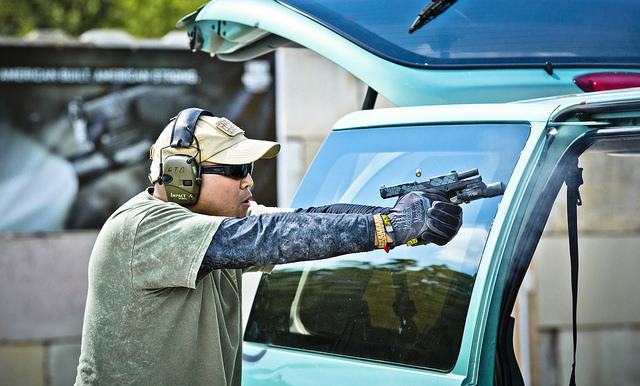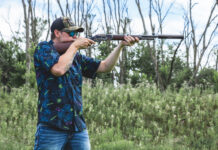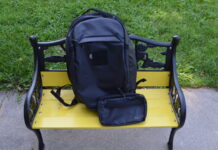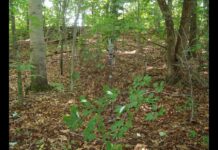
By: Clarence Banez, Field Editor – MASF Member
AAR Sentinel Concepts, Vehicle CQB Course
May 29-31, 2015
Location: Alliance, Ohio PD Training Facility
Instructors: William Petty & Steve Fisher
Course description:
Live fire problem solving course focused on fighting around vehicles. Also included was a ballistics demonstration of various caliber ammunition in pistol, rifle, shotgun to assess effective cover locations on a car. Identify weak areas to avoid while engaged in a violent encounter. Test the ballistic protection of windows, sections of the car, front/rear windshields and doors. Live fire drills consisted of single and two person partner scenarios. Fighting outside around the vehicle as well as fighting from inside the car to outside. Daylight as well as low light scenarios drills. Stress induced exercise (alphabet soup) designed to track threats and practice shooting above, around and under the car, while maximizing use of cover. We took breaks watching dash cam video of actual shootings that occurred from the LEO perspective. On the last training day, we finished with force on force UTM practice against each other to summarize cumulative lessons learned. This was an open enrollment class consisting mainly of LEO’s, military veterans, contractors, and civilians like myself. It was my first time training with cars so I was happy to be learning from the SME’s of this course.
 Weather: TD1 morning was sunny and hot in the high 80’s. Held throughout the day. TD2 was overcast in the morning then fluctuated with sun and sporadic showers. At night time it cooled down a bit to around the mid 60’s and 70’s that ended in a downpour around midnight. TD3 was sunny in the morning in the 80’s with sporadic showers. In the afternoon it was overcast.
Weather: TD1 morning was sunny and hot in the high 80’s. Held throughout the day. TD2 was overcast in the morning then fluctuated with sun and sporadic showers. At night time it cooled down a bit to around the mid 60’s and 70’s that ended in a downpour around midnight. TD3 was sunny in the morning in the 80’s with sporadic showers. In the afternoon it was overcast.
Gear: Glock 30s, M&P pro series, Surefire ultra WML, Blackbeard Tactical kydex holsters, Raven Vanguard 2, HSGI taco mag pouch.
Goals: To learn how to effectively fight around and in vehicles.
TD1: After getting our paperwork and intros out of the way in the classroom, we geared up, stepped on the line for basic warm ups/draw strokes. Eventually we progressed to shooting in unorthodox positions. From squatting position, to knees, proned out on our backs and stomach. Eventually the “urban prone” would be an unorthodox position that we all were familiar with by the end of the training session.
We took a break to discuss the physical design of the vehicle. The protective functions of cars, safety purposes of protecting occupants. The body of the vehicle from the front of the car (A) to the rear (C or D) was dissected and broken down into pillars. The engine block, tire and rims and the chassis areas between doors were designated to pillars A,B,C, and (D if a van or SUV). These areas would be essential throughout the course as primary cover areas against incoming rounds. A critical area to take cover, maneuver around, do administrative work, reloads, remedial action if necessary, etc.
After setting up paper targets around multiple cars, we started dry practicing movement from pillar to pillar, squatting, kneeling, and urban prone position. Then went live, took turns engaging targets above, to the front and rear of the car as well as underneath with 2 pant legs simulating a threat. After, we headed back in the class room to watch dash cam videos, debrief on the drills thus far, questions, concerns, etc. At this point since I was very new to this, I felt really awkward and sloppy. Eventually I would get more comfortable with more repetitions and practice.

After lunch, we had the ballistics demonstration. A paper target was set up parallel to the passenger side of the car. William and Yeti alternated, shot on pillar A with various fmj and jhp, bonded as well as non bonded ammo. We started with 380 auto going all the way to 45 cal, then 1 oz slugs, then 5.56, blackout, up to 308. Throughout each test, we examined if penetration occurred through 1 or 2 pillars, through the car completely and onto the paper target. The results were astonishing. Most did not even penetrate through one pillar. I was certain at least the 308 round would hit paper, but only managed to break through pillar 1 and stop at pillar 2. Within the car, most projectiles were trapped inside the first pillar, or broke through 1 pillar and hit the front windshield or the rear view mirror. Next, we focused on ballistic protection of doors. A target was placed in front of an opened door about 4 meters out. Yeti shot through the driver side door. First spreading a group around different locations of the door, then stacking rounds in one hole. The door failed miserably as pistol rounds easily penetrated through. Stacking rounds increased effectiveness in connecting accurate hits on target. After we tested front and rear windshields. I was thinking rounds would cut right through. Especially since we used 1 oz slug for this portion. I was wrong again. From our results, shooting rounds from the front to the rear proved sufficient cover. Rounds going in the front windshield tended to deviate trajectory towards the front seat. Meaning very good to be behind the rear of the car, very bad to be fighting seated against an armed threat. Overall we were all in shock of the results of this tests. Practically all of my guesses were incorrect.
After the ballistics demo, a small hydration break, we went back into live fire drills with 2 man partner drills. Doc was my partner and helped me greatly throughout the drill. We had a smooth run communicating and effectively clearing each car. Targets were located in the same manner as the first exercise. Use of temple index to ensure safe muzzle discipline was of the highest importance during this drill. Overall we all did fine, some mistakes, indexing while kneeling, or indexing too much while approaching the next car where potential threats were. We ended the day around 5pm, debriefed in the classroom.
TD2: We started the day at 10am. Getting back into live fire, we were introduced to the dreaded “Alphabet soup”. I had no idea what I was getting into, and was curious as to why we were setting up multiple targets and steel with letters and numbers around the van. The primary objective was to track threats, above, below and around the vehicle. William or Yeti would yell out the letter or number indicated to engage. And change the location sporadically. And if the wrong target was hit or the student was not in urban prone when shooting the parallel targets to the front and rear end of the car, you would be DQ’ed. This drill required extreme focus, compartmentalization of information as well as stamina. For most of us, we completed the drill fine. It was mentally and physically stressful, failure points were reached, marksmanship declined. Although I finished, I could feel my body mechanics getting sloppy. Marksmanship degraded as fatigue increased. I had to force myself to breath and slow down to get effective hits on target. After finishing the drill we were all exhausted and out of breath. We took a break, debriefed, re-hydrated, and carried on.

Next, we did a dry fire run from inside the car with a partner. One driver and one front side passenger. We were reminded to stack rounds through one hole to make positive hits on target. 2 steel targets were placed about 3 yards from the front windshield. Going live, we each had 2 runs, alternating as a driver and front side passenger starting seated inside the car, seat belt on. Once the audible signal of “threat” was given. We engaged the steel targets in front of us through the front wind shield, unbuckled, exiting and shooting on the move to the rear or temple indexing (moving) to the rear of the car using pillars and the rear windshield as cover, switching sides while maintaining muzzle discipline, temple indexing when appropriate.
We took a long meal break before getting into low light drills. Night runs were more difficult in addition to rain. Overall we all did fine working from one car to the next. Some students used support side lights while shooting strong side. Most students used wml’s on their pistols. An extra step of lumens was added to the equation in order to obtain visual situational awareness, information gathering in order to solve the problem. I made the mistake of tac reloading before clearing the rest of a car. I was getting more used to urban prone, and less sloppy on my body mechanics. At this point, I got better using pillars for scanning, reloading, malfunction clearance, etc.

TD3: We started the day reviewing lessons learned so far. Use of cover, ballistic protection in the pillars, windshields, more mindset tips, etc. We began live fire drills with a partner clearing cars, communicating with each other and then moving on to the next car. I was happy to have Doc help me out again. I started to rush most of the time and had to force myself to slow down. After break, we had another session of alphabet soup. I felt better the second time around took deep breathes throughout the drill. I felt more improvement second time around, able to track targets audibly by William. I had trouble getting the steel targets in the middle. After the first minute, fatigue had already started affecting shot placement. I was just trying to remember using the pillars while reloading or squatting low to transition from target to target. Focusing on maintaining muzzle discipline, staying behind the gun, constantly scanning, and staying low. Even though it was about 2 and a half minutes, it felt like 30 minutes of hell. Just mentally and physically frustrating to the point where I was completely out of curse words to yell at myself in order to press on. Drill ended, and I was just happy to have fished. Overall we all did great.
After debriefing and a break. We packed up our pistols and ammo, got briefed in the classroom about the force on force drills to finish the course. We put on extra layers to absorb the utm rounds, frisked each other to make sure no back up pistols or knives were on our persons. Then got to it. One student would start at the front right tire, other student at the rear left tire. We alternated use of helmets and with our face protection took turns engaging each other, practicing use of pillars shooting above and around the car. Once hit, the winner would stay, those defeated would allow another student to challenge the winner. At first my utm pistol wasn’t in battery. I went up against Ollie and got tagged pretty good. We went again and the second time around we both knocked each other out. After this final exercise, we cleaned up the range, swept all broken glass and debris, moved steel targets back. Debriefed outside on the benches, received our certs, said our good byes and headed home.

Lessons learned: William and Yeti pretty much explained the whole curriculum at the start. It really didn’t make sense until all the videos, dry/live fire exercises, force on force and especially the ballistics tests put everything into context. Adding on to what I learned in previous classes with Yeti, in particular the handgun shoot house. It is essential to compartmentalize information, especially when the SHTF combined with adrenaline, tunnel vision affecting the decision making process. Obtaining information is already difficult under stress, without composure and focus, critical mistakes could be made, moving too fast outside of cover, muzzle discipline deteriorating, improper identification of threat/non threat. A million things can go wrong at a second’s notice and then you are faced with a snap decision. Inaction or the wrong action could be fatal or degrade further.
Just like in hand gun shoot house. It’s all about using angles to your benefit. You may not like where you are when SHTF, but you must respect the geometry of the fight. Use angles to your advantage. Positioning yourself with optimal cover behind pillars, minimizing your exposure, positively identifying threats and acting decisively with the information available.
Muzzle discipline is of the highest priority. From observing others and taking note of myself. There were times where muzzles came too close to feet in urban prone. Or with fatigue grabbing onto the vehicle and muzzling an arm. Or while practicing temple index. I know I was guilty of indexing once or twice on my knee. But as the training progressed I got more comfortable using it. Yeti reinforced it best. “Stay behind the gun. Gun first, it always takes priority.”

Act “sooner rather than faster”. This was repeated frequently. You don’t realize how fast you are moving under stress, with adrenaline, the unnecessary motions and exposure could be costly. What I got from this phrase and this class is, you can still be proactive, maximize your movement to your advantage and be efficient provided you have the necessary information to act. Not to be mistaken with rushing. But more or less capitalizing on time rather than wasting time making the wrong snap decision, then wasting more time trying to correct your mistake. A couple seconds may seem like a lifetime, but acting too quickly without thinking leads to bad decisions. Every movement should have a focused objective. If not by necessity to evade, deliberate action should always lead to a position of strategic advantage, ie, better cover, line of sight to obtain more information or engage, or important territory to control.
Fight from high to low. I was also wrong at first scanning low under the car, then to above. Always identify threat from above and engage under if that is your best option to minimize exposure. If the only available target is the feet, legs. Chop that tree down and go to work until the threat is stopped. I questioned when to maintain close distance to the vehicle. It is when threats have the advantage of an elevated position.
Body mechanics was something to take note of in others as well as myself. With fatigue inevitably coming to us all. It was easy to see sloppiness, moving sluggishly, keeping the head too high, not staying low behind cover, marksmanship deteriorate, muzzle discipline degrading. Doing administrative functions, reloads, remedial action behind insufficient cover such as behind doors, in between pillars etc. So much is already going on. I made critical mistakes going beyond the pillars. I got better towards the end with my movement, keeping my core tight, taking deep breathes throughout, squatting low and moving side to side. I eventually figured out a more efficient way to get into urban prone. By judging the distance to the end of the car, staging my knees first at a certain reference point on the doors, then elbows in order to lay parallel behind pillars with just my head and pistol protruding enough around the front or rear tires. But importantly, doing so with minimal exposure of the torso. The first time doing alphabet soup, fatigue had gotten me to misjudge my distance and urban prone too far out exposing my upper torso. The second time around, I felt better, more fluid in my movement and this helped me focus on using the pillars more efficiently. This would prove to be essential during force on force.

Train with the gear that fits your needs and your daily EDC. Utilize your own customized setup, either a LEO with body armor, duty belt, or a CHP holder concealing IWB, appendix, strong side, etc. Too often, and I admit I have been guilty in the past of this, training with different gear and not the current EDC tools that we live our lives in. This time, I made sure to give honest trigger time with my Raven VG2 appendix. Did some draw strokes, got used to the mechanics, etc. After I felt comfortable, I switched over to my kydex holsters for winter time carry. Made a sincere effort to run them hard like I would be in a fight for my life, scratched them up, making sure my every day gear does not reach unacceptable failure points.
Evolving beyond square range mentality. From watching the dash cam video. The definition of a violent encounter is displayed. An altercation that happens in seconds notice. In a short time frame, usually very violent in nature. William emphasized fighting from the position you are in, rather than a position of comfort. I think many of us, especially civilians become complacent with square range mentality. It’s one thing to have a timer and be set in your fighting stance, shooting comfortably at paper targets. It is a completely different animal when that paper target is shooting back at you. Depending on the mission at hand, whether you are a LEO doing a routine traffic stop with too many unknown factors, or a civilian like myself going from point A to B, where violent encounters have occurred, road rage, armed robberies, kidnappings, etc. Train with your own personal setup and get used to shooting from positions where you are in your daily life, sitting (car, at a restaurant, movie theater), on your back, lying down, squatting, kneeling, urban prone. It would be nice if bad guys gave us the opportunity to get comfortable, in our fighting stances, press check, then begin the fight. But the real world just does not work like that.
This was reinforced during our final force on force exercise. All that square range crap goes out the window. I wasn’t in battery when we started. Even though I asked. I should have made sure to confirm the condition of my pistol. When we started, Ollie within seconds closed distance and shot me even before I could respond with remedial action. We restarted, second time around I did better staying low behind the pillars. Even though we both knocked each other out at the same time, had a draw. It raises important questions for those who take self-defense seriously. Observing the utm hits on my body. I was struck the first time on my upper left chest, two to the abdomen. Second round I got hit on the left wrist and shoulder. Would I be able to fight with just my strong side? If there were more problems after this altercation, such as multiple threats, would I be able to fight injured? Have the focus to scan loved ones and myself for serious injury? Is my EDC sufficient for this? Can I apply a tourniquet to myself or a loved one hit and maintain composure? I sincerely hope I would.
I am humbled to have realized how easily it is to be shot at within such a short time frame. As said above. From common sessions on the square range, qualifying for a job, or just doing drills on the clock. Most of us only train to shoot at paper targets but rarely think about how easily it is to be shot back. William said it best. “Assume your threat is more skilled or just as prepared as you.” I am glad I went up against an aggressive skilled opponent like Ollie. Because it was an important moment of learning for me. That just because you have the tools, train with them, do you honestly challenge yourself enough, treat it seriously as if your life and those you love depend on it? Is your current training regimen sufficient enough to survive against one or multiple bad guys? I’ve never really done force on force, but I now see why it is so damn important to participate in.

In conclusion:
I could easily write more on this AAR but did my best to organize my thoughts on such vast information. In short, this has been the most eye opening, mentally/physically stressful course I have ever taken. I came with the expectation to learn an essential skill and didn’t expect to be so overloaded with important information. So many damn light bulbs happened, my notebook was just filled from page to page. On the first day, William marked 18 points of effective cover on a van. At the beginning, many of us completely underestimated a car’s protective capability. I thought for sure AK rounds cut through cars like a hot knife through butter. But the ballistics demonstration put all the false Hollywood assumptions to rest. Basically, for those serious about defending loved ones and yourself, as a civilian, especially LEO’s, this class should be a requirement. You will leave with very odd looking bruises and cuts on your torso, elbows, knees, but the lessons taught are priceless. I will take the course again just to get more repetitions in. It’s not often we get to shoot at cars and train around vehicles. So I have nothing but positive opinion from this course. Come humble, have gloves, knee/elbow pads, have decent cardio, and definitely bring a notebook/pen.
Finally, I can’t thank William and Yeti enough for the knowledge bombs they dropped on us. Not just the science and strategic information but also the mindset. Controlling emotions under stress proves to be extremely difficult, but training can at least mitigate the bad decisions often made during chaotic violent encounters. We can’t control when we get ambushed by belligerent violence nor can we control when we have to punch that card. But what we can control is using this knowledge and quality training, repetitions to fight our way out of bad situations into better ones, mainly to protect our loved ones and live another day. We have no choice but to perform our best under extreme duress, the worst conditions thinkable and hope we default to the extra knowledge gained and repetitions practiced. William said it best. It’s easy for anyone to Monday night QB an opinion watching dash cam video, but say it again when you actually are in the situation, under stress, adrenaline, clouded by tunnel vision. Do some alphabet soup, then give an opinion after that. It isn’t sufficient amount of training that is lacking, but the type of training one receives. I pray to God that I will never have to use this knowledge in an actual fight, but I feel enriched with the knowledge gained from this course. So that’s it for now. God bless, stay safe and keep on rocking friends!
Clarence (Big Larry)
SOURCE ARTICLE: http://masf.co/2016/03/20/after-action-review-aar-of-sentinel-concepts-vehicle-cqb-course/



